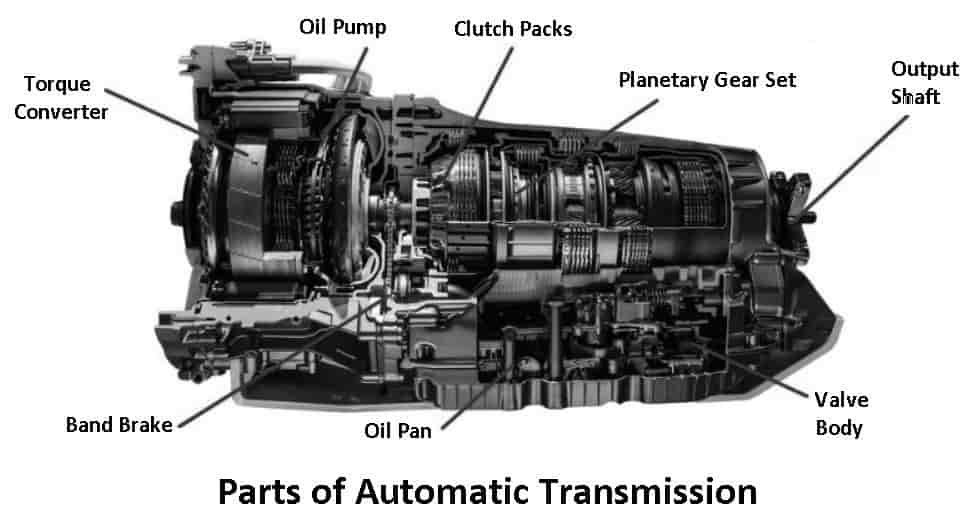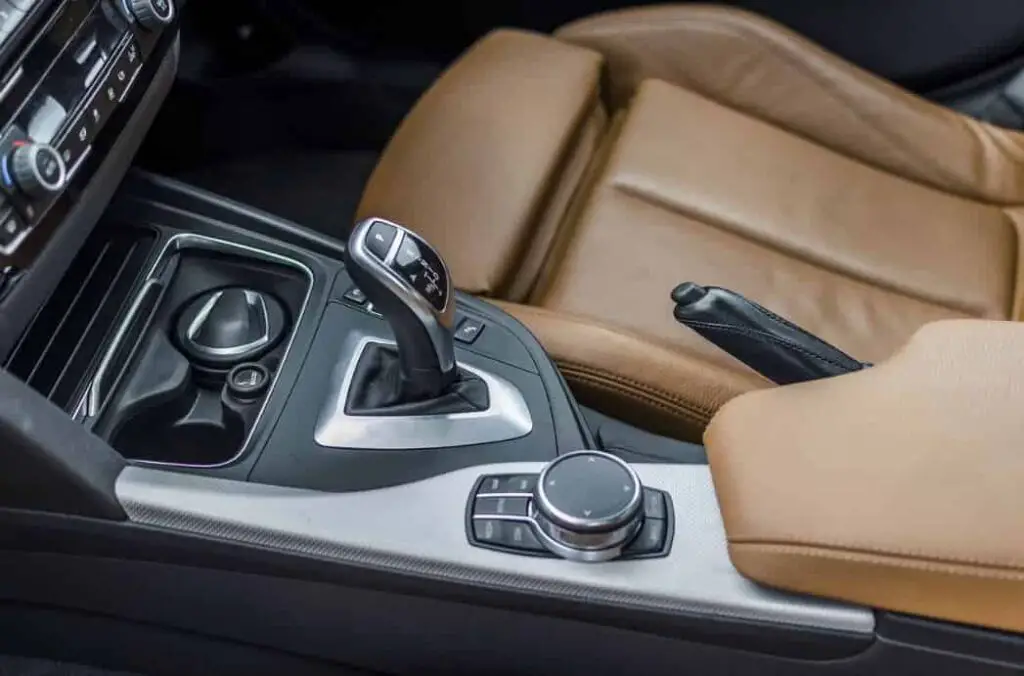In this article, you’ll learn What is Automatic Transmission. Its diagram, parts, working, advantages, and applications all are explained with pictures.
Also, you can download the PDF file at the end of this article.
What is an Automatic Transmission?
An automobile may seem simple to operate because we use them daily, yet they are extremely complicated machines. The automatic transmission is among the most complex systems found in a conventional car.
An automated transmission is a multi-speed transmission used in automobiles that does not require the driver’s input to change forward gears under typical driving conditions. As a result, when the car moves, automatic gearboxes change the gear ratio.
Sensors in automatic transmissions use internal oil pressure to shift gears at the appropriate time. The torque converter handles shifting gears as the transmission and engine are disconnected.
An automatic car can be identified by looking at its pedals. An automobile is referred to as automatic if it has two pedals. The clutch pedal is a third pedal seen in manual automobiles.
People with disabilities can also drive automatic cars because they only need two usable limbs. The absence of a clutch or gear stick also allows the driver to focus more on the road.
Read Also: Different Types of Transmission Systems Used In Car
Parts of Automatic Transmission
Let’s examine the main parts of an automatic transmission and their functions:
#1 Torque Converter
The torque converter is just a fluid connection that connects the engine to the transmission. It consists of two primary components: the turbine and the impeller, which are both immersed in transmission fluid.
The engine spins the impeller, creating a flow of fluid that drives the turbine, which transfers power to the gearbox.
#2 Oil Pump
Automatic transmissions need an oil pump to distribute transmission fluid throughout the system. It assures that the fluid required for lubrication and cooling reaches the torque converter, clutches, and other parts.
#3 Planetary Gear Set
The key part of an automatic gearbox is the planetary gear set. It has a sun gear, a planet carrier with several planet gears, and a ring gear.
The car may shift gears smoothly and travel forward or backward by engaging different combinations of these gears in the transmission to create different gear ratios.
#4 Clutch Packs
Various parts of the planetary gear set are engaged and disengaged by clutch packs, also called friction discs or plates.
The clutch packs stick together when hydraulic pressure is applied, enabling certain gears to engage and transfer power.
#5 Output Shaft
The output shaft transfers power from the transmission to the vehicle’s driving wheels. It attaches to the planetary gear set and uses the engine’s rotational torque to move the car forward or backward.
#6 Brake Band
Some automatic transmissions employ brake bands to exert resistance or hold certain components. They regulate gear engagement by enclosing a drum that is attached to a certain gear or shaft and are turned on hydraulically.
#7 Oil Pan
Transmission fluid is stored in the oil pan, which sits at the bottom of the gearbox. Furthermore, it has a transmission filter, which aids in clearing the fluid of impurities.
#8 Valve Body
In an automatic transmission, the valve body serves as the control center. It has some channels and valves that control the clutch pack and band engagement as well as the flow of transmission fluid.
To smoothly and effectively change gears, the valve body measures hydraulic pressure in response to signals from the vehicle’s computer (ECU).

Function of Automatic Transmission
- The torque converter connects the engine and transmission, allowing power to be transferred.
- Transmission fluid is circulated to keep the system lubricated and cool.
- Planetary gear sets offer variable gear ratios for both forward and reverse.
- Clutch packs use hydraulic pressure to engage and disengage gears.
- Power to the driving wheels is transferred via the output shaft.
- Gear engagement is managed by band brakes.
- The valve body automatically shifts gears by controlling fluid flow.
- Depending on the driving situation, sensors and the ECU (Electronic Control Unit) coordinate gear changes.
- The entire system works together to deliver smooth and effective gear changes, which allow the vehicle to move and accelerate.
Working of Automatic Transmission
Most automatic transmissions employ hydraulic power to move gears, combining a torque or fluid coupling converter with gear sets that supply the vehicle’s desired range of ratios.
The engine is connected to the transmission by the torque converter, which transfers power to the gears via pressurized fluid. The car can stop without stalling because of this, which replaces a manual friction clutch.
The pump transforms engine power into transmission fluid, which powers the torque converter’s turbine. This increases the fluid’s power, which allows the turbine to receive additional power.
Consequently, a vortex power rotation is produced, spinning the turbine along with the central shaft that is attached. This power travels from the shaft to the transmission’s first planetary gear set.
Read Also: How does a hydraulic braking system work?
Types of Automatic Transmission
There are several varieties of automatic transmissions, each with unique benefits and features. The main categories of automatic transmission systems are as follows:

#1 Torque Converter
The earliest type of automatic gearbox is the torque converter, which is a beauty of engineering. A torque converter uses two turbines—one attached to the engine and the other to the transmission—instead of a clutch.
The engine turbine transfers power to the transmission turbine through a fluid that sits between the two turbines. Although they are more costly, torque converters are just as effective as their manual equivalents.
Torque converter-equipped cars include the Ford EcoSport, Mahindra Thar, Tata Safari, and Kia Seltos.
#2 Automated Manual Transmission (AMT)
The Automated Manual gearbox (AMT) is an automatic gearbox that employs an actuator and an onboard computer to identify which gear to change at which engine speed. You must use the selection stick that comes with AMTs to choose the drive mode.
After it’s engaged, you can kick back, relax, and drive; the AMT will engage the clutch and change ratios for you. The AMT shifts gears automatically during up and downshifts, so you might feel a little jerk. Otherwise, it is smooth.
The AMT transmission system is inexpensive and may be found in vehicles such as the Tata Nexon, Maruti Suzuki Wagon R, Hyundai Grand i10 Nios, and many others.
#3 Continuously Variable Transmission (CVT)
CVT, or continuously variable transmission, is a more recent kind of automatic gearbox. With this type of transmission, the gear ratios are constantly changing according to the vehicle’s speed.
To do this, two conical pulleys are connected by a belt whose diameter changes depending on speed, weight, incline, and decline.
Since the car moves at different speeds, the CVT is incredibly efficient since it attempts to keep the engine revolutions per minute (RPM) constant.
#4 Dual Clutch Transmission (DCT)
The Direct Shift Gearbox, also known as Dual Clutch Transmission, uses two clutches to instantly shift ratios. It is operated by two clutches that operate odd and even gear groups of 1 3 5 and 2 4 6 respectively.
Unlike AMT and manual transmissions, this gear design avoids power loss because the gears are already engaged and prepared to be deployed as soon as one gear rpm is reached.
A DCT transmission provides a seamless and effective driving experience and is typically seen in luxury vehicles.
#5 Intelligent Manual Transmission (IMT)
The iMT transmission, unlike other transmissions, requires manual gear shifting without a clutch. When the gear stick moves, sensors provide data to an actuator, which then engages the clutch. Similar to a manual transmission, the driver controls fuel economy and gear changes.
Advantages of Automatic Transmission
Here are some advantages that drivers of automated cars might enjoy:
- In high-traffic areas, automatic transmission vehicles are easier to operate. Automatic vehicles are simple to start and stop with just one pedal push.
- The transmission operates quickly and smoothly. In an automatic car, drivers don’t need additional effort to shift the transmission because technology does it for them.
- It’s simpler to learn how to drive an automatic transmission car. It needs more experience to drive a manual car than an automatic one.
- Automatic cars are less likely to stall unless there is a mechanical issue.
- These vehicles perform well in hilly terrain.
Disadvantages of Automatic Transmission
The following problems could arise if you drive an automated car:
- They can be more costly to buy. Comparing automatic cars with manual cars might result in a price difference of almost $4,000.
- Driving an automatic requires less concentration. It also means that drivers may choose to engage in activities that are distracting, which may result in collisions.
- It might result in less fuel efficiency. Generally speaking, manual cars are more fuel-efficient than automatic ones.
Conclusion
That’s it. Thanks for reading. I hope I have covered everything about the “Automatic Transmission” It would be helpful if you could let me know if there was anything I missed or if you have any doubts about anything I wrote.
Please share this article with your friends if you find it interesting.
Want free PDFs direct to your inbox? Then subscribe to our newsletter.
Download PDF file of this article:
Read more in our blog:
- What are the different types of turbochargers?
- Types of Differentials & How They Work?
- 21 Types of Trucks & Their Uses [Explained]
FAQs
With an automatic transmission, you never have to consider which gear to shift because the transmission changes ratios for you automatically based on the driving situation. A manual transmission allows you to choose which gear to use and when to shift.
They will require more costly and periodic care. Compared to manuals of the same make and model, automatics have a somewhat shorter lifespan. An automatic transmission gives the driver less control than a manual transmission does.
From the driver’s point of view, an automatic car is more convenient and easy for drivers to operate regularly. On the other hand, a car with a manual transmission is more affordable and gives the driver greater control.
Automatic transmission vehicles change gear based on the RPMs, so the car needs to maintain high RPMs in hilly regions. Therefore, it would be advised that you choose a car with a manual transmission since it gives you more control over the vehicle.
Great article! The explanations about Automatic Transmission were really clear and helpful. It’s definitely cleared up some misconceptions I had about automatic transmissions.
Thank you! I’m glad you found the article clear and helpful.
Is it possible to have an automatic gear box repaired?
What needs to be replaced/ serviced therein and after how long
Absolutely! Automatic gearboxes can be repaired. Components like solenoids, seals, and clutches might need replacement. Servicing intervals vary but generally recommended every 30,000-60,000 miles for longevity.